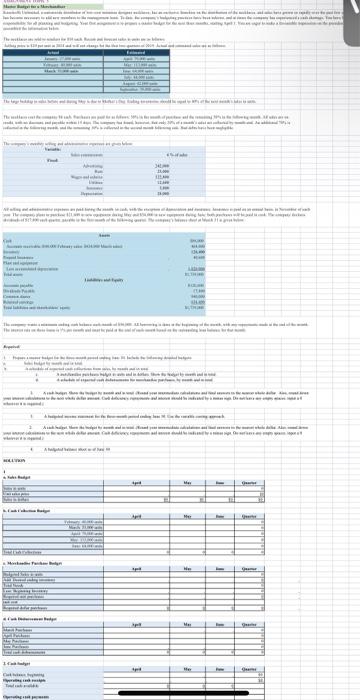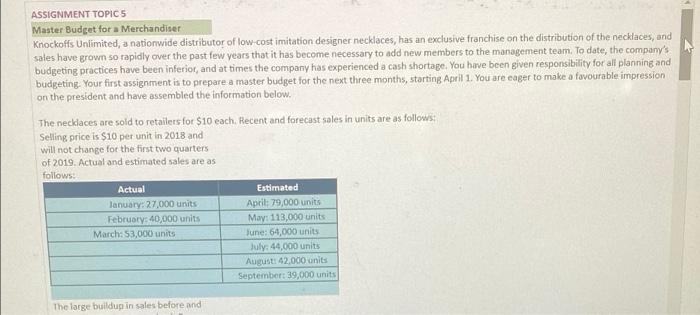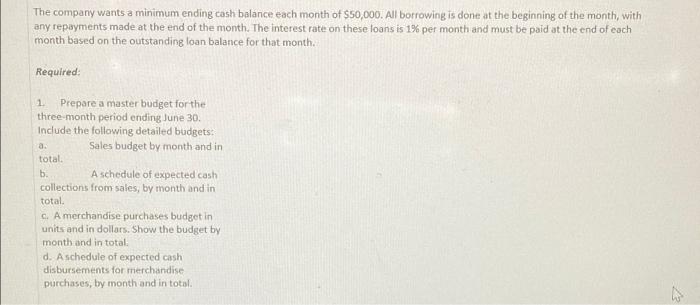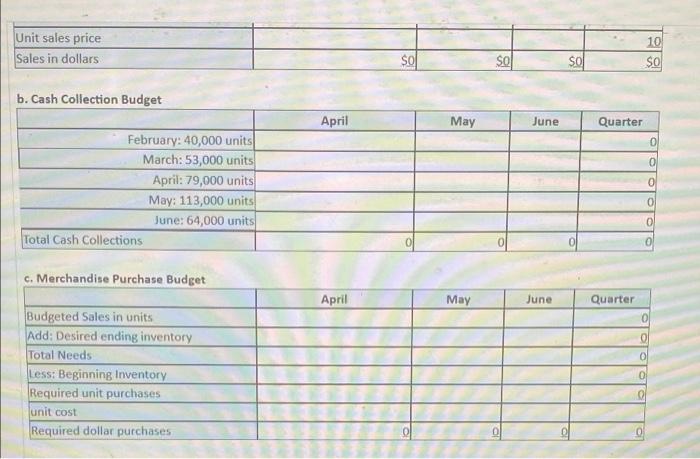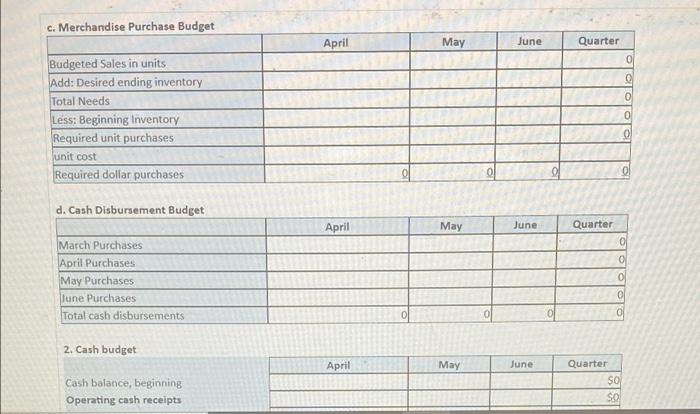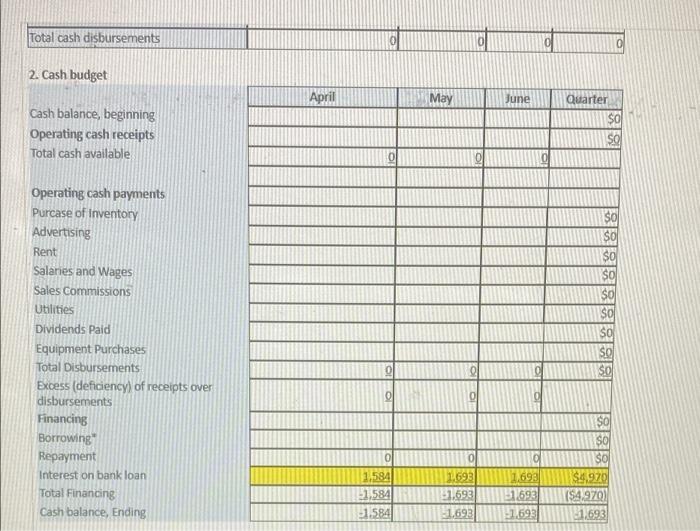Thu w www VERT Mer ME T what TI . cm him mm ASSIGNMENT TOPIC 5 Master Budget for a Merchandiser Knockoffs Unlimited, a nationwide distributor of low-cost imitation designer necklaces, has an exclusive franchise on the distribution of the necklaces, and sales have grown so rapidly over the past few years that it has become necessary to add new members to the management team. To date, the company's budgeting practices have been inferior and at times the company has experienced a cash shortage. You have been given responsibility for all planning and budgeting. Your first assignment is to prepare a master budget for the next three months, starting April 1. You are eager to make a favourable impression on the president and have assembled the information below. The necklaces are sold to retailers for $10 each. Recent and forecast sales in units are as follows: Selling price is $10 per unit in 2018 and will not change for the first two quarters of 2019. Actual and estimated sales are as follows: Actual Estimated January 27,000 units April 79,000 units February: 40,000 units May: 113,000 units March:53,000 units June: 64,000 un July: 44,000 units August: 42.000 units September: 39,000 units The large buildup in sales before and The large buildup in sales before and during May is due to Mother's Day Ending inventories should be equal to 40% of the next month's sales in units. The necklaces cost the company S4 each. Purchases are paid for as follows: 50% in the month of purchase and the remaining 50% in the following month. All sales are on credit, with no discount, and payable within 15 days. The company has found, however, that only 20% of a month's sales are collected by month end. An additional 70% is collected in the following month, and the remaining 10% is collected in the second month following sale. Bad debts have been negligible. 4% of sales The company's monthly selling and administrative expenses are given below: Variable: Sales commissions Fixed: Advertising Rent Wages and salaries Utilities Insurance Depreciation 242,000 25,000 122,800 12,600 5,800 28,000 Depreciation 28,000 All selling and administrative expenses are paid during the month, in cash, with the exception of depreciation and insurance. Insurance is paid on an annual basis, in November of each year. The company plans to purchase $21,600 in new equipment during May and 554,000 in new equipment during June; both purchases will be paid in cash. The company declares dividends of $17,800 each quarter, payable in the first month of the following quarter. The company's balance sheet at March 31 is given below: $88,000 464,000 126,400 40,600 Assets Cash Accounts receivable ($40,000 February sales; 5424,000 March sales) Inventory Prepaid Insurance Plant and equipment Less accumulated depreciation Total assets Liabilities and Equity Accounts payable Dividends Payable Common shares Retained earnings Total abilities and shareholders' equity 1,020,000 51,739,000 $126,800 17,800 M0,000 654,400 $1,739,000 ws The company wants a minimum ending cash balance each month of $50,000. All borrowing is done at the beginning of the month, with any repayments made at the end of the month. The interest rate on these loans is 1% per month and must be paid at the end of each month based on the outstanding loan balance for that month. Required: 1 Prepare a master budget for the three month period ending June 30. Include the following detailed budgets: Sales budget by month and in total b. A schedule of expected cash collections from sales, by month and in total. . A merchandise purchases budget in units and in dollars. Show the budget by month and in total d. Aschedule of expected cash disbursements for merchandise purchases, by month and in total 2. A cash budget. Show the budget by month and in total. (Round your intermediate calculations and final answers to the nearest whole dollar. Also, round down your interest calculations to the next whole dollar amount. Cash deficiency, repayments and interest should be indicated by a minus sign. Do not leave any empty spaces; input a O wherever it is required.) 3. A budgeted income statement for the three-month period ending lune 30. Use the variable costing approach 2. A cash budget. Show the budget by month and in total. (Round your intermediate calculations and final answers to the nearest whole dollar. Also, round down your interest calculations to the next whole dollar amount Cash deficiency, repayments and interest should be indicated by a minus sign. Do not leave any empty spaces; input a 0 wherever it is required.) 4. A budgeted balance sheet as of June 30. SOLUTION 1 a. Sales Budget April May June Sales in units Unit sales price Sales in dollars Quarter 0 10 so SO 10 Unit sales price Sales in dollars so Sol 18 so b. Cash Collection Budget April May June Quarter 0 0 0 February: 40,000 units March: 53,000 units April: 79,000 units May: 113,000 units June: 64,000 units Total Cash Collections O 0 c. Merchandise Purchase Budget April May June Quarter 0 0 0 Budgeted Sales in units Add: Desired ending inventory Total Needs Less: Beginning Inventory Required unit purchases unit cost Required dollar purchases 0 To c. Merchandise Purchase Budget April May June Quarter 0 0 Budgeted Sales in units Add: Desired ending inventory Total Needs Less: Beginning Inventory Required unit purchases unit cost Required dollar purchases 0 d. Cash Disbursement Budget April May June Quarter 0 0 March Purchases April Purchases May Purchases lune Purchases Total cash disbursements 0 o con 0 2. Cash budget April May June Cash balance, beginning Operating cash receipts Quarter SO SO Total cash disbursements 2. Cash budget April May June Quarter $0 Cash balance, beginning Operating cash receipts Total cash available SO $0 $0 $0 So Operating cash payments Purcase of Inventory Advertising Rent Salaries and Wages Sales Commissions Utilities Dividends Paid Equipment Purchases Total Disbursements Excess (deficiency) of receipts over disbursements Financing Borrowing Repayment Interest on bank loan Total Financing Cash balance, Ending 191919191 0 0 0 1.584 -1.584 01.584 0 1.693 $1,693 1,693 698 516931 1693 Sol $4.970 ($4.970) 21.693 Thu w www VERT Mer ME T what TI . cm him mm ASSIGNMENT TOPIC 5 Master Budget for a Merchandiser Knockoffs Unlimited, a nationwide distributor of low-cost imitation designer necklaces, has an exclusive franchise on the distribution of the necklaces, and sales have grown so rapidly over the past few years that it has become necessary to add new members to the management team. To date, the company's budgeting practices have been inferior and at times the company has experienced a cash shortage. You have been given responsibility for all planning and budgeting. Your first assignment is to prepare a master budget for the next three months, starting April 1. You are eager to make a favourable impression on the president and have assembled the information below. The necklaces are sold to retailers for $10 each. Recent and forecast sales in units are as follows: Selling price is $10 per unit in 2018 and will not change for the first two quarters of 2019. Actual and estimated sales are as follows: Actual Estimated January 27,000 units April 79,000 units February: 40,000 units May: 113,000 units March:53,000 units June: 64,000 un July: 44,000 units August: 42.000 units September: 39,000 units The large buildup in sales before and The large buildup in sales before and during May is due to Mother's Day Ending inventories should be equal to 40% of the next month's sales in units. The necklaces cost the company S4 each. Purchases are paid for as follows: 50% in the month of purchase and the remaining 50% in the following month. All sales are on credit, with no discount, and payable within 15 days. The company has found, however, that only 20% of a month's sales are collected by month end. An additional 70% is collected in the following month, and the remaining 10% is collected in the second month following sale. Bad debts have been negligible. 4% of sales The company's monthly selling and administrative expenses are given below: Variable: Sales commissions Fixed: Advertising Rent Wages and salaries Utilities Insurance Depreciation 242,000 25,000 122,800 12,600 5,800 28,000 Depreciation 28,000 All selling and administrative expenses are paid during the month, in cash, with the exception of depreciation and insurance. Insurance is paid on an annual basis, in November of each year. The company plans to purchase $21,600 in new equipment during May and 554,000 in new equipment during June; both purchases will be paid in cash. The company declares dividends of $17,800 each quarter, payable in the first month of the following quarter. The company's balance sheet at March 31 is given below: $88,000 464,000 126,400 40,600 Assets Cash Accounts receivable ($40,000 February sales; 5424,000 March sales) Inventory Prepaid Insurance Plant and equipment Less accumulated depreciation Total assets Liabilities and Equity Accounts payable Dividends Payable Common shares Retained earnings Total abilities and shareholders' equity 1,020,000 51,739,000 $126,800 17,800 M0,000 654,400 $1,739,000 ws The company wants a minimum ending cash balance each month of $50,000. All borrowing is done at the beginning of the month, with any repayments made at the end of the month. The interest rate on these loans is 1% per month and must be paid at the end of each month based on the outstanding loan balance for that month. Required: 1 Prepare a master budget for the three month period ending June 30. Include the following detailed budgets: Sales budget by month and in total b. A schedule of expected cash collections from sales, by month and in total. . A merchandise purchases budget in units and in dollars. Show the budget by month and in total d. Aschedule of expected cash disbursements for merchandise purchases, by month and in total 2. A cash budget. Show the budget by month and in total. (Round your intermediate calculations and final answers to the nearest whole dollar. Also, round down your interest calculations to the next whole dollar amount. Cash deficiency, repayments and interest should be indicated by a minus sign. Do not leave any empty spaces; input a O wherever it is required.) 3. A budgeted income statement for the three-month period ending lune 30. Use the variable costing approach 2. A cash budget. Show the budget by month and in total. (Round your intermediate calculations and final answers to the nearest whole dollar. Also, round down your interest calculations to the next whole dollar amount Cash deficiency, repayments and interest should be indicated by a minus sign. Do not leave any empty spaces; input a 0 wherever it is required.) 4. A budgeted balance sheet as of June 30. SOLUTION 1 a. Sales Budget April May June Sales in units Unit sales price Sales in dollars Quarter 0 10 so SO 10 Unit sales price Sales in dollars so Sol 18 so b. Cash Collection Budget April May June Quarter 0 0 0 February: 40,000 units March: 53,000 units April: 79,000 units May: 113,000 units June: 64,000 units Total Cash Collections O 0 c. Merchandise Purchase Budget April May June Quarter 0 0 0 Budgeted Sales in units Add: Desired ending inventory Total Needs Less: Beginning Inventory Required unit purchases unit cost Required dollar purchases 0 To c. Merchandise Purchase Budget April May June Quarter 0 0 Budgeted Sales in units Add: Desired ending inventory Total Needs Less: Beginning Inventory Required unit purchases unit cost Required dollar purchases 0 d. Cash Disbursement Budget April May June Quarter 0 0 March Purchases April Purchases May Purchases lune Purchases Total cash disbursements 0 o con 0 2. Cash budget April May June Cash balance, beginning Operating cash receipts Quarter SO SO Total cash disbursements 2. Cash budget April May June Quarter $0 Cash balance, beginning Operating cash receipts Total cash available SO $0 $0 $0 So Operating cash payments Purcase of Inventory Advertising Rent Salaries and Wages Sales Commissions Utilities Dividends Paid Equipment Purchases Total Disbursements Excess (deficiency) of receipts over disbursements Financing Borrowing Repayment Interest on bank loan Total Financing Cash balance, Ending 191919191 0 0 0 1.584 -1.584 01.584 0 1.693 $1,693 1,693 698 516931 1693 Sol $4.970 ($4.970) 21.693
